Does your child need some help with their handwriting, fine motor, and letter recognition skills? These 6 activities that can be used alone or in an obstacle course are perfect for preschool and kindergarten age kids, and are easily adapted for older kids too!
Ten years ago, I would’ve been mortified, but in that decade I had 3 kids. I learned a lot about letting go of perfectionism (my former M.O.) and going with the flow. Well, mostly.
I was fully aware that my youngest son in his first of year of preschool was a little behind on his fine motor skills, letter recognition, and handwriting.
He’s a very active kid that even at this young age is obsessed with sports, even though we as his parents aren’t. That meant he wasn’t too interested in coloring, writing, or crafts that I would offer him.
Hence why I wasn’t surprised when his well-meaning preschool teacher looked at me in the middle of the parent teacher conference and said, “I was surprised you weren’t working with him more, you know because you’re a pediatric occupational therapist.”
Whomp, whomp.
In her defense, she wasn’t being rude, just honest. I wasn’t offended in any way because I did give him opportunities to participate, but he just wasn’t interested. I knew we had some time.
I continued to encourage coloring, crafts, cutting, and writing, which he did minimally. I could’ve forced him to participate, but that usually isn’t effective.
Now that he’s in the latter half of his second year of preschool, it became clear that his handwriting and fine motor skills weren’t getting better. With kindergarten looming, I knew I was going to have to step up and be his mom and his OT.
The gap between him and the other kids in his class was getting bigger, it was time to address his fine motor and handwriting skills head on.
When Kids Refuse to Practice Handwriting and Fine Motor Skills
As his mom, I had to be creative so that he’d be as willing to participate as possible. The dynamic is different when you’re working with a child in a therapy session that isn’t your own. I can usually get them to do a lot that their parents can’t.
As James’ mom, I knew I was going to have a harder road ahead and the one thing I wanted to avoid was turning this “practice” or basically therapeutic activities into something he hated and fought me on.
That would only make him resist writing in school and even impact him in a learning environment for years to come.
This is why I haven’t been forcing for the past few years, but we didn’t have a choice any longer. For there to be any chance at him trying his best without any drama, I needed a game plan.
Is Your Child’s Handwriting a Mess? This is How We’re Tackling It…
I decided that we would have what I dubbed “learning time” for 15-30 minutes M-F around 9 am. He needed a lot of practice, so we jumped into 5 days a week. That’s not always necessary. First thing in the morning was a good time for us since he goes to preschool in the afternoon. Plus, his brothers are at school and that helps keep distractions down.
I always remind him that we’ll be doing a special activity soon, so that he isn’t caught off guard. This helps a lot with his willingness to participate.
When it finally came time to participate though, I wasn’t surprised that he pushed back a little. He got upset at this new activity in his life and so for the first day or two, we let him pick a fun activity to do afterwards. He needed a lot of encouraging words and patience on my part that first week.
But, I also tried to give him choices in the activities we did. I knew that coloring, writing, stringing beads, cutting, and many more would all help him. Often times, I’ll give him a choice between 2-3 different things to choose from. This gives him a sense of control.
And, most kids love obstacle courses, which is why this is one of the first hand writing activities we did.
Here are some more tips for you to think about as you create your own plan:
- Decide how many days you’ll be working on handwriting/fine motor skills a week
- Pick a time and day(s) of the week to do fine motor/handwriting activities and be consistent so it becomes part of your routine
- Make a list of activities you can do during your fine motor time. (Use the ideas below!)
- Be ready to adapt activities. If something seems too hard for your child, they might not be ready for it yet, make it a little easier for them and then work your way up to the more challenging activities
- Focus on keeping this time positive and enjoyable, knowing that it can take some time to get used to
- Offer your child 2-3 choices of activities if they’re reluctant to participate
- Ask them what activity they’d like to do next – after their fine motor time is over
- Be careful not to make it last too long, 10-15 minutes is a good start. Over 30 minutes will be too long for most kids, but if they’re willing, keep it going!
Affiliate links used below. See our full disclosure.
The Fine Motor – Handwriting Obstacle Course
Since my son loves to move, I wanted to try a simple obstacle course that literally took me 3 minutes to set up. Occupational Therapists love using obstacle courses because a child can work on a variety of skills in one activity. It usually helps keep kids interested and not get burnt out on over doing any one activity.
I’m going to share 6 different fine motor and handwriting activities with you. Each are powerful and will help your child improve their fine motor strength and coordination, letter recognition, and/or handwriting.
You can use these activities individually, mix them up, or leave out any that your child may not need.
Step 1 of the Obstacle Course:
Have your child lay on their belly on top of a scooter board (here’s one I like on Amazon) and push themselves using just using their hands for 8-12 feet, or even longer if you have the space. You might be wondering what this has to do with handwriting? A lot, actually. To keep it simple, when kids bear weight down on the palms of their hands, it helps improve their fine motor skills.
Your child can also achieve weight bearing through wheelbarrow walking, walking like a crab, rolling over a ball on their belly and catching themselves on the ground with their hands.
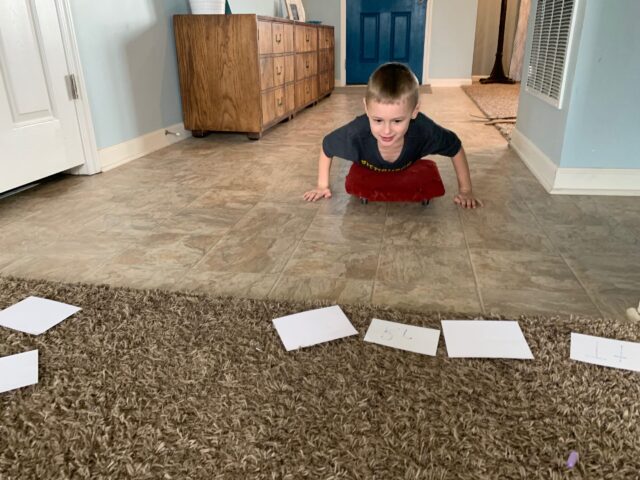
Step 2:
I had 10 or so flashcards flipped upside down at the end of scooter boarding area. I had chosen letters that he struggled to consistently identify. Once he pushed himself down to the cards, he’d flip one over and tell me what it was or make a guess. You can easily write out letters on index cards or pick up a set. Whatever you choose, make sure the letters are plain.
Busy cards or ones with embellishments may be confusing or distracting to your child that is trying to learn the shapes letters make.
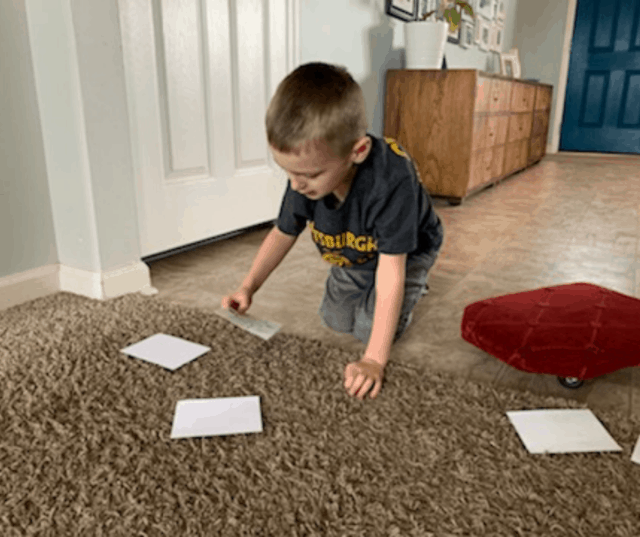
Step 3:
Use simple letter “shapes” to make the letter from the flashcard. We had a station set up on a child’s desk a few feet away from the flash cards with Handwriting without Tears wooden letter pieces. Handwriting Without Tears is an evidence-based program created by an OT to teach children handwriting.
These basics shapes can be put together in different ways to form all the upper case shapes in the alphabet. When children use them, it gives a hands-on sensory experience for actually feeling the letters, which helps some kids learn better! You can grab a plastic magnetic version on Amazon here or create a set with card stock.
Step 4:
Pull a hidden object out of putty. I like using this inexpensive therapeutic grade putty, because it’s excellent for strengthening the muscles of the hand, but any putty could work as long as you can hide hard objects in it. I placed small magnetic letters in the putty so he’d pull one out and then tell me what the letter was.
This can be a challenging task for kids with low fine motor strength.
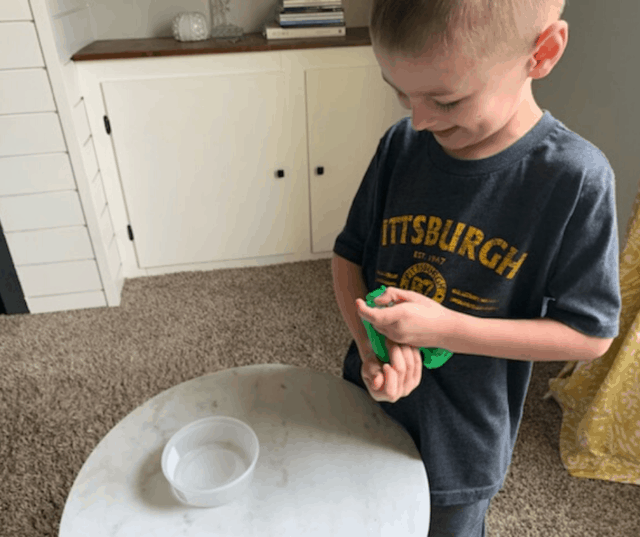
Step 5:
Climb through a pop up tunnel. James wanted to add this to our obstacle course, which was a perfect addition. I put it in between two of the activities and he got some more weight bearing as he climbed through.
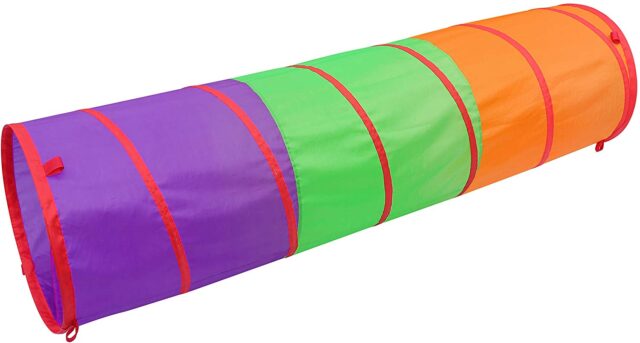
Step 6:
Write the letter from the flash card on the wall with chalk. Regular old school chalk usually wipes right off a painted wall, but test a small area first in your home or use a chalkboard.
The reason I have him writing on the wall is because it’s a vertical surface, which forces his grasp into a better position. It’s also a little more challenging and builds up the fine motor strength and control. This was very challenging for James and we had to negotiate him writing each letter 4 times. Make sure you have lines drawn on the wall or chalkboard for them to write in.
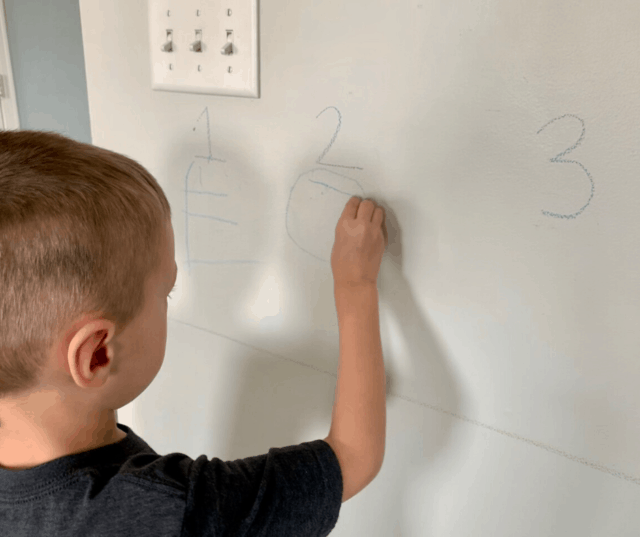
That was the end of the obstacle course. Then he’d start over again with the scooter board. He completed it about 6-7 times, each time through only taking 3-4 minutes.
Here’s an overall view of the obstacle course, but make any adaptations you need for your own space. I had James ride the scooter board down a hallway without carpet and then make a loop around the furniture in our living room.
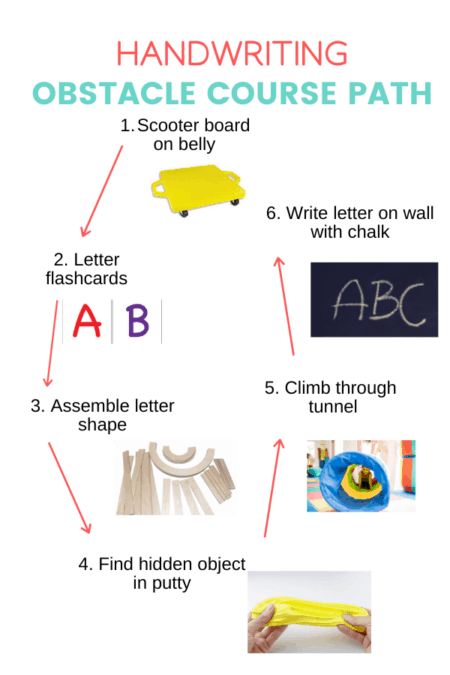
I Had This Big Realization After the Obstacle Course…
This obstacle course was day 1 or 2 of our new fine motor time. As he wrote on the wall in the obstacle course, I realized that because his fine motor skills were a little behind when he started preschool, he didn’t really learn the proper way to form the letters, which led to messy wild writing nobody could read.
While I could’ve just kept working with him on the letters at random, I realized quickly that I needed to teach him the right way to form on the Uppercase letters first, then the Lowercase. I ordered this Handwriting Without Tears Workbook from Amazon because in my opinion as an OT it’s the best program for kids to learn handwriting.
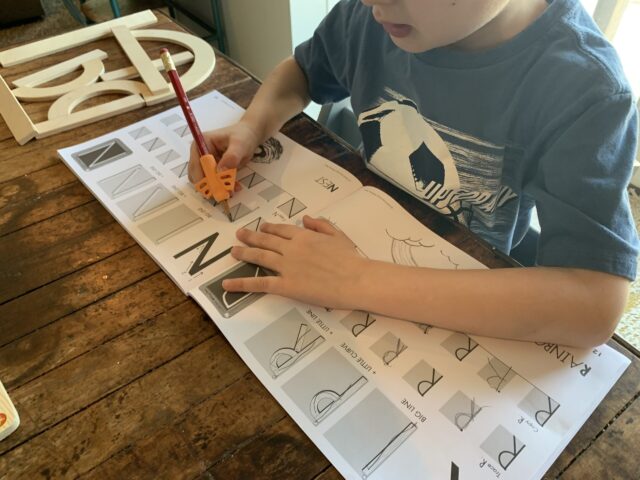
It includes simple verbal cues the kids can easily learn and also provides visual perceptual support.
Workbooks can be a little boring for some kids, so we don’t use it everyday, but I’m already seeing an improvement with James’ writing since we went back to the beginning and taught him the letters. Of course, all the other activities we’re doing are helping too!
If you’re child isn’t preschool age, Handwriting Without Tears has dozens of workbooks depending on what your child needs are. Some focus on pre-writing skills, cursive, just uppercase letters, or just lower case. Identify what area your child needs to work on and then get the coordinating workbook.
If you have questions about your kid’s handwriting difficulties, leave it in the comments below! Since it’s the first time I’ve wrote about handwriting and fine motor skills on Your Kid’s Table, I also want to hear from you in the comments if you want to learn more tips and strategies in these areas. I’ve got loads more I could share!
More on Child Development Skills
Incredible Child Development Toys to Help Your Child Thrive
5 Ways to Use a Scooter Board for Sensory Input
Learn Crossing Midline Activities to Improve Your Child’s Development!
Alisha Grogan is a licensed occupational therapist and founder of Your Kid’s Table. She has over 15 years experience with expertise in sensory processing and feeding development in babies, toddlers, and children. Alisha also has 3 boys of her own at home. Learn more about her here.
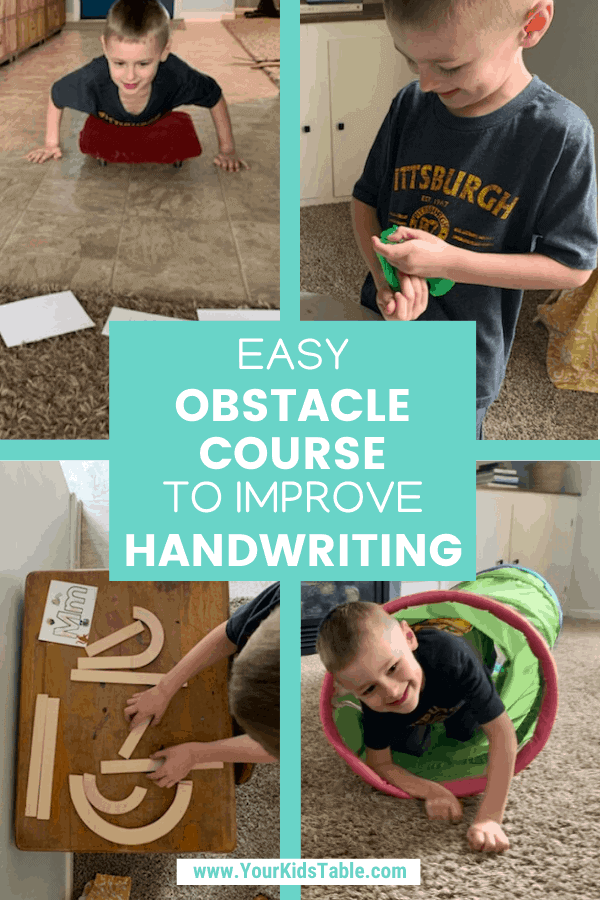
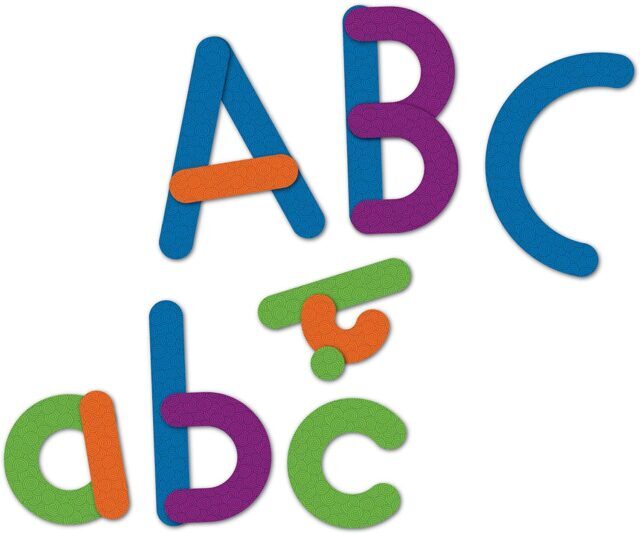
Very helpful post. I am a PT and can totally relate how this works?
The best part is now I know I am on right track.
Thank you
Hi Dhara,
That’s so awesome to hear that this is helpful to you as a PT! We love hearing that 🙂 Thanks so much for sharing.
Best,
Andrea
Very helpful. But i need tips and tricks for 16 months old. She is already behind. We are working with OT and just started with early intervention. But little progress. I already implemented your tips for mealtime and having progress there. Thank you for posting this. Really appreciated it!
Thank you very much for this article! My 7 year old son is behind in his fine motor skills. I’d really like to help him in this area, but dont know where to start! Your article is just the right thing I need to get started! Thank you!!
Can a regular kids skate board be used in place of the scooter board? We have a.little skate board, it is narrow though.
Hey Amy,
Yes, if the child can lay down on it. You are really looking for them to be utilizing their arms to pull them forward on it 🙂
Best,
Desiree
Awesome Amy!! So glad this was helpful for you!
Thank you so much for this article! I’d love to see more! As a homeschooling home of boys ages 4 and 7, my older son has struggled with a lot of fine motor tasks! Keep the info coming!
Hey Karissa,
Thanks so much for your feedback, we love hearing about what you need! We will keep that in mind 🙂
Best,
Desiree
Thank you! I understand so much more now why we are doing what we are doing in OT! I didn’t get that that the scooter board helped fine motor skills. I also didn’t really consider doing that at home. Ah ha moment 🙂
Awesome Shannon!! So glad you had that moment and made that connection! 🙂
Best,
Desiree
Alicia, amazing post, thank you so much for sharing! You are learning everyday as a Mom and as an OT, I am glad to see how you can connect all sensory aspects of a child development! I am a huge fan!
Thanks Cristina! I am learning too. It’s been really wonderful to work with my son like this, it’s all classic OT stuff that’s been so rewarding. Always thankful for your support:)
Should they be learning handwriting in pre-K?
Hey Ann,
Yes in most cases they do! These activities would be really helpful!
Best,
Desiree
Thank you for sharing this information! Your timing is perfect, as this topic is relevant for us right this minute. 😊
This was great to read! I love that it relates to active boys into sports (I have 2 of them!) And tips that are helpful for sensory kids in any area are great!
So glad you enjoyed it and can relate!! Hope this makes it easier for you 🙂
Best,
Desiree
Awesome Katherine,
So glad to hear it! Keep us posted on any “wins” 🙂
Best,
Desiree
Love! Thanks for sharing! Our oldest is just turning 3, so I’ll keep this in my back pocket for the near future. I would love to hear tips & strategies! Do you have any for a kid learning how to dress himself? Our son really struggles in this area (maybe normal for 3? I have no idea 🤷)
Hey Kate!
For your 3 year old, this is normal. I’d start with dressing that is simple tasks, taking off socks, jackets, etc. I’d try to talk about each step as you are helping him get through each one, so he can hear the steps repeated over time! Try making sure you are helping, but that he is working towards it also, rather than just doing it! This can help kids gain their independence!
Best,
Desiree
Nicely done. Do you have a printable copy without ads or full page vis half page?
Hey Eileen,
So happy that you enjoyed this post! We do not have anything in a printable format for this post at this time!
Best,
Desiree